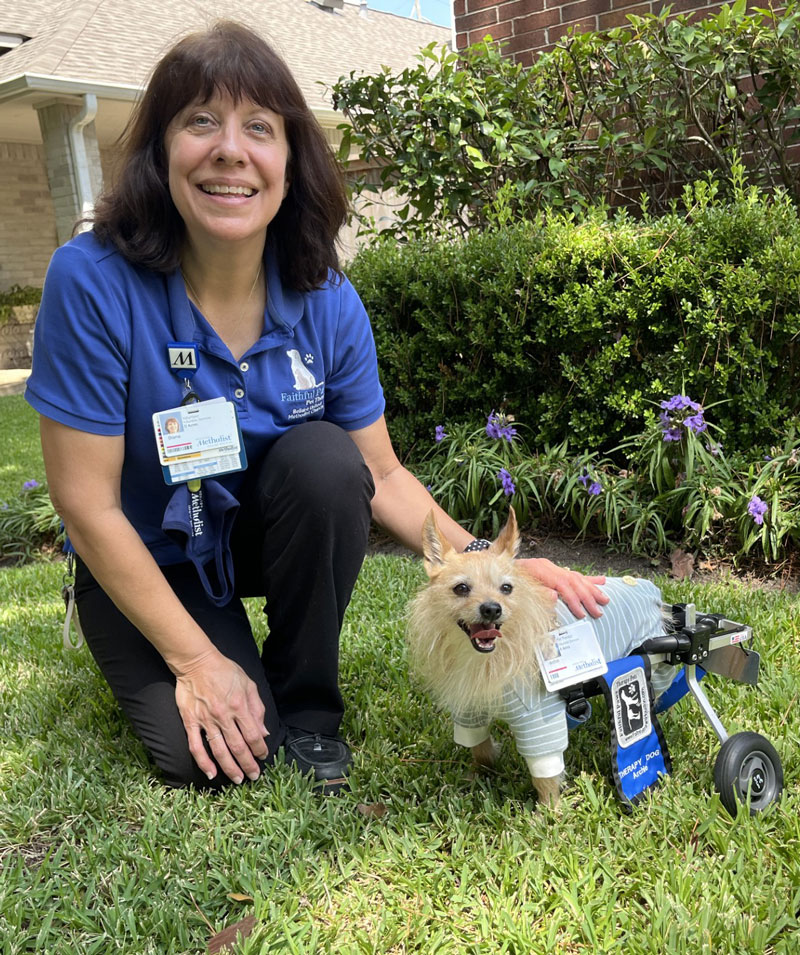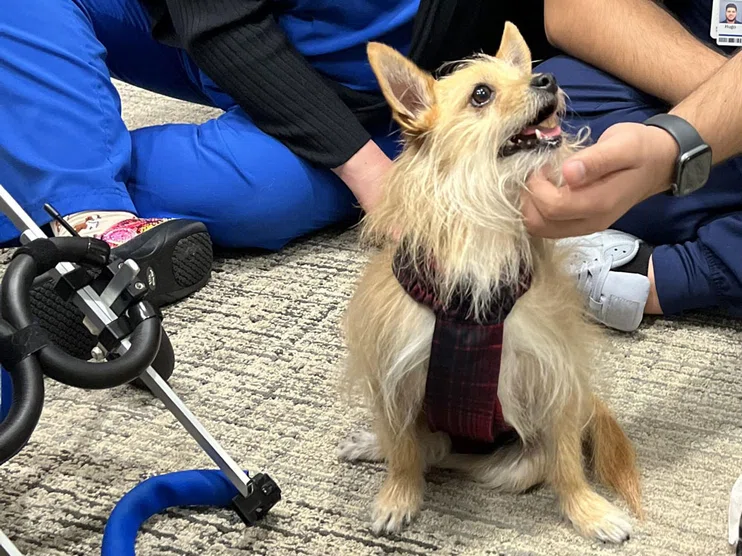© 2025. Houston Methodist, Houston, TX. All rights reserved.


In this
issue

WELCOME
NURSING SCIENCE

Holistic Care and the Use of Aromatherapy in Clinical Practice

Utilizing Music Therapy in Nursing Research
EDUCATION

Spiritual Care and Nursing Across the Houston Methodist System

Beyond Medicine: The Impact of Pet Therapy in Healthcare
PRACTICE

Narration of Care: A Bridge to Whole-Person Healing

Sweet Dreams, Sharp Minds: How Holistic Nursing and Sleep Hygiene Are Teaming Up to Tackle Delirium
PROFESSIONAL DEVELOPMENT
MAGNET
FROM OUR TEAMS

ABOUT DISCOVERN
EDUCATION
Beyond Medicine: The Impact of Pet Therapy in Healthcare
By Vanessa Parejo, MPH, Volunteer Services,
Houston Methodist Hospital
By Vanessa Parejo, MPH,
Volunteer Services,
Houston Methodist Hospital
In today’s healthcare landscape, holistic care is more than a philosophy—it’s a practice that recognizes the interconnectedness of physical, emotional and psychological well-being. Pet therapy has emerged as a powerful and compassionate tool among the many approaches that support this whole-person model. By introducing trained therapy animals into clinical environments, Houston Methodist fosters moments of joy, comfort and connection that complement traditional medical treatments.
Whether easing anxiety, lifting spirits or inspiring resilience, pet therapy helps bridge the gap between clinical care and emotional healing, making it essential to a genuinely holistic approach to patient wellness.
In this article, Diana Acres, a dedicated pet therapy volunteer from one of the three organizations that support Houston Methodist, discusses her journey from patient to healer, exemplifying the profound impact of pet therapy. She brings hope, laughter and emotional relief to patients and staff alike, demonstrating how pet therapy is vital to holistic healing in modern healthcare.

What inspired you to become a pet therapy volunteer, and how did you get started?
In November 2015, I adopted Archie. He had a broken back and a severed spinal cord—but he was so happy. I knew he had a special purpose in life, and I wanted to help him find it. Six months later, I was diagnosed with acute myeloid leukemia. K9 Angels Rescue offered to take Archie back since I couldn’t have him during my treatment, but I told them that he would be the reason I lived —and that I very much wanted to keep him.
I was treated at Houston Methodist and healed. My husband told me I was given a wonderful second chance at life and encouraged me to follow my inspiration. I immediately knew that I wanted to train Archie to be a pet therapy dog and go back and promote the patients at Houston Methodist, just as I had been encouraged.
Can you tell us a bit about your therapy animal—what makes them special in a hospital setting?
Archie is a tiny Chihuahua Pomeranian mix with a big personality. He is the happiest, most inspiring little guy I have ever met. When people see him in his wheelchair, so happy and excited to see them, they can’t help but smile—or even laugh, and laughter does the heart good like medicine.
Archie is especially inspiring to patients undergoing physical therapy and staff members who are having difficulty. They feel that if he can be happy with his disability, they can keep trying too—and maintain a good attitude.
How does pet therapy contribute to patients' emotional and physical well-being?
Study after study has proven the positive effects of pet therapy, both emotionally and physically. It’s been shown to reduce blood pressure, relieve pain, increase their feel-good hormones, and even help knee replacement patients heal faster. A doctor once thanked me for bringing patients hope because, without hope, there is little that medicine can do.
How do patients typically respond to your visits, especially those who may be anxious, in pain, or undergoing long-term treatment?
They are always so excited to see us. Sometimes their laughter turns to tears of joy or tears of anxiety as they release their fears and worries by petting Archie. During every visit, they were grateful that we came and thanked us for making their day.
Pet therapy has often been a pivotal moment that changed the course of a patient’s recovery. Archie routinely visits patients in the Continuing Care Hospital at Houston Methodist in the Texas Medical Center. Both patients and staff look forward to seeing him roll down the hallways each Thursday. Even the doctors are excited to see him and stop to pet him!
What feedback have you received from nurses about the impact of pet therapy on their patients?
We love to come alongside nurses and help them with their patients! Sometimes, they’ll tell us about someone who received bad news or is struggling that day, and we’ll visit. The next time we see them, they’ll thank us because the patient did better after our visit.
Many times, they will call us to visit, and once they see what a positive effect it has on their patients, they will usually be repeat requesters. That makes us so happy!
What challenges do you face when bringing a therapy animal into a busy hospital environment?
We usually have a planned schedule of visits, but the challenge is simply making it down the hallway! So many people want to stop, say hello, pet Archie, share stories about their dogs, and ask me about Archie. We delight in this “problem” because those spontaneous moments are often the most impactful!
What does volunteering at Houston Methodist mean to you?
It means the world to me! I have the opportunity to work alongside and encourage those who saved my life and to inspire those who are going through a difficult journey, like I did.
How do you envision the future of pet therapy in healthcare settings?
Pet therapy is evolving, and we must evolve with it. We have been so successful in doing that through collaboration with doctors, nurses, and staff at Houston Methodist. Studies continue to show that pets positively impact patients and health care workers who face high stress daily. We are so grateful to be included in the holistic approach to care. It takes a village!










